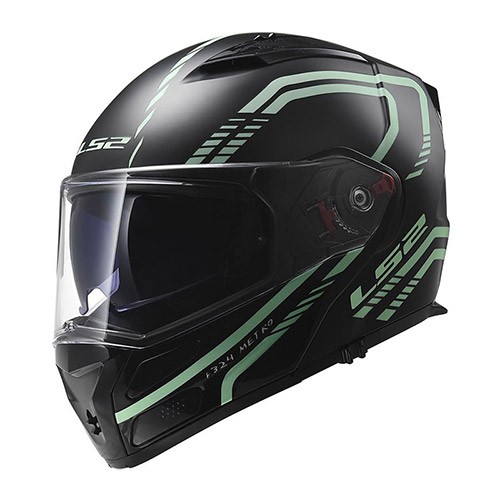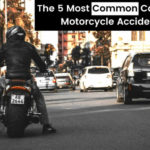The open-air nature and freedom of the road are what make motorcycle rides so exciting. Unfortunately, it also leaves riders more prone to injury. According to the National Highway Traffic Safety Administration, the fatality rate for motorcycles is 27x higher compared to passenger cars.
Based on the latest available data from 2017:
- Motorcycles make up 3% of all registered vehicles in the US, yet accounts for 14% of all road fatalities.
- Motorcycles were more frequently involved in fatal collisions with fixed objects than other vehicle types.
- Frontal impacts account for 76% of motorcycle-to-car crashes, compared to just 7% in rear impacts.
- There were nearly two times more fatalities during the weekend than on weekdays.
- Supersport bikes with owners under 30 years old had a 4x higher fatality rate than other bike owners.
So what are the most common causes of motorcycle accidents, and how can you avoid them?
1. Left Hand Turns
The most common motorcycle accident involves a vehicle making a left-hand turn in front of motorcycles. According to the NHTSA, among two-vehicle collisions that resulted in a fatality, 42% were caused by a vehicle turning left, while the motorcycle was going straight, passing, or overtaking. While this would normally result in a fender bender or blown airbags for enclosed vehicles, the lack of a steel cocoon leaves motorcycles more prone to injury and material damage.
How to avoid left-hand turning accidents:
- For this scenario, defensive driving is the best tactic. Riders need to anticipate the intent of motorists in front, especially when lane splitting or passing.
- Be familiar with your bike’s braking distance, and maintain a suitably safe gap from the vehicle in front.
- Instead of relying solely on turn signals, observe other turning indicators. These can include slowing down, drifting slightly to the left, or head-turning.
- Watch out for gaps in traffic in front while someone is waiting to go. Always assume that another driver will pull out.
- When in doubt, look at the direction of the driver’s head and the tires.
2. Speeding
Speed plays a huge role in motorcycle crashes. Speeding was responsible for 32% of motorcycle crash deaths in 2017, compared to just 18% for passenger cars.
In addition, among two-vehicle collisions involving a motorcycle, bikes above 125ccm accounted for 40% of crashes, mostly due to excessive speed. The same study found that injuries were likely to be more severe the higher the engine displacement.
How to avoid speed-related accidents:
- When out on the road, it’s easy to get lost in the wind and the thrill of open tarmac. But when your neck is on the line, it pays to keep the throttle in check.
- Always follow the speed limit, even in sparse traffic. A sudden stop or uneven deceleration can easily result in a wobble, slide or worse.
- Know your bike’s braking distance and tire grip depending on the weather and road surface. This can mean the difference between a Hail Mary stop and a collision.
- Riding thrill isn’t always about speed. Turns and elevation changes can be fun and challenging too.
- When in doubt, ease up on the throttle and reserve it for the track.
Remember: The faster you go, the quicker your reaction time needs to be. The average reaction time is 1.2 to 1.5 seconds. At 50mph, a bike can travel over 100 feet before the rider even starts to react.
3. Visibility
Bad weather, low light conditions, or inconspicuous safety gear are some of the factors that can lead to an accident caused by poor visibility.
Even in perfectly clear conditions, stricter vehicle safety regulations mean that today’s cars have higher beltlines and thicker A-pillars, all of which can reduce visibility.
How to avoid motorcycle crashes due to poor visibility:
- Make sure your safety gear has high-visibility markings. New Zealand research found that riders who wore reflective or high fluorescent gear had a 37% lower risk than other riders.
- The same study found that white-colored helmets had a 24% lower risk than black helmets, while light-colored helmets had a 19% lower risk. This is echoed by another study in the British Medical Journal which found that white helmets are the most visible.
- Use your headlights even in daylight to increase your head-on visibility. Riders who turned on their headlights during the day are 27% safer than those who don’t.
Avoid riding in other vehicle’s blind spots:

- Avoid lane splitting, or reserve it for the first and second lanes where motorists are more accustomed as advised by the California Highway Patrol.
- Before going on a ride, check the weather bulletin and road conditions. A thick fog condition can drop visibility down to 130-650 feet.
- Weigh the risks. If it’s essential to go out in driving rain or a pitch-black night, consider taking the four-wheeler instead.
If you’re interested in suiting up safely, check out our content on gear:
The Ultimate Guide to Motorcycle Safety Gear
A Beginner’s Guide to Types of Motorcycle Helmets
How to Choose The Safest Motorcycle Helmet 2020
The Lightweight Motorcycle Helmet Guide for 2020
4. Inexperience
According to the Highway Loss Data Institute, a motorcycle rider is 4x more likely to crash during the first month than in their entire second year of ownership. In fact, nearly a quarter of motorcycle insurance claims made from 2003-2007 occurred during the first month of the insurance policy.
However, inexperience is not limited to riding time alone. It can also happen when switching to a new bike, upgrading to a bigger engine displacement, traversing a new route, or riding in an unfamiliar weather condition.
How to avoid motorcycle accidents due to inexperience:
- When riding for the first time, practice on a closed course or enroll in a riding class.
- Look where you want to go. This allows you to anticipate the route before turning the bike. It also signals other drivers where you intend to go.
- Make it a habit to do a pre-ride inspection. Start with your safety gear, then do a walkaround of the bike. Check fluids, tires, brakes, and belts/chains.
- When switching motorcycles, treat it as if it was your first time riding a bike. Each bike has its own unique riding dynamics, quirks, and challenges that will take time to familiarize yourself.
- If going through a new route, look it up on the map. Pay particular attention to accident-prone areas like busy intersections, on and off-ramps, tight curves or switchbacks.
- Take your time while traversing the route. Even the best GPS maps can’t account for road hazards like potholes, obstructions, and construction zones.
- Changes in elevation can also be a challenge even for experienced riders. Never underestimate an uphill climb or downhill ride.
- When riding during an unfamiliar weather season like rain or snow, do your homework and prep accordingly. Read up on tips and experiences, and be sure to rainproof or winterize yourself, your gear, and your ride.
Remember that age is not a mirror of experience. In fact, NHSTA records show that the 50-and-up group had the most motorcycle fatalities among all age groups.
5. Alcohol
In 2017, approximately 35% of all motorcycle deaths in the US were caused by driving under the influence. Of those, 28% were alcohol-impaired with a BAC level of .08 or higher. In addition, among all vehicle classes, motorcycles had the highest fatality rate due to DUI.
Other sobering statistics:
- 43% of motorcycle riders who died in single-vehicle crashes were alcohol-impaired.
- The highest rate of DUI deaths was in the 40-49 age group.
- Riders killed in nighttime crashes were 3x more frequently found to be impaired by alcohol.
- 47% of motorcycle riders who died in alcohol-related crashes were not wearing helmets.
How to avoid motorcycle accidents due to alcohol:
- Keep alcohol to the absolute minimum.
- Know your own personal limit. States have their own legal limits ranging from 0.05 to 0.10 BAC. However, this differs from your own body’s threshold — only you know what your safe limit is.
- Even at low BAC levels, loss of inhibition can diminish judgment and cause the brain to take greater risks. If you find yourself feeling more reckless or giddier than usual, there’s a good chance you’re alcohol-impaired.
- In one closed-course drunk riding test, it was found that inebriated riders were incapable of divided-attention driving. So if your route home lies along busy city streets or fast-moving highways, don’t risk it.
- When hitting the town, plan for alternative rides home, whether it’s a friend’s ride or an Uber.
- If there’s no alternative ride available, stay where you are, find a place to rest, and let the alcohol effect subside before riding. On average, a moderately intoxicated person sobers up in about 6-8 hours.
- Some of the things you can do to shake off the effects of alcohol are taking a nap, hydrate to flush out the alcohol, drink caffeine to increase alertness, and exercise to speed up the metabolism of alcohol.
- The best defense: Don’t drink. Motorcycles require more motor skill and coordination than regular vehicles while providing less safety. All it takes is one bottle or glass to impair balance, degrade skills, and slow your reaction time.
Conclusion
Motorcycle riding provides one of the most rewarding experiences on the road. The open air and deft response of a bike can turn even a regular commute into an exhilarating trip. However, along with the excitement comes safety.
Know yourself and your bike, plan ahead before each trip and drive defensively. Taking proper precautions can mean the difference between getting a thrilling ride and being an NHTSA statistic.


